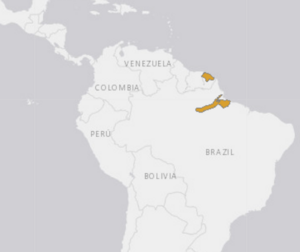Dark-spotted anaconda facts for kids
Quick facts for kids Dark-spotted anaconda |
|
|---|---|
| Conservation status | |
| Scientific classification | |
| Genus: |
Eunectes
|
| Species: |
deschauenseei
|
 |
|
| Dark spotted anaconda natural range | |
The dark-spotted anaconda (scientific name: Eunectes deschauenseei) is a type of snake. It is also known as De Schauensee's anaconda. This snake belongs to the Boinae group, which is part of the Boidae family.
Like all boas, this anaconda is not venomous. Instead, it wraps around its prey and squeezes it. This snake lives in the northeastern parts of South America. There are no different types (subspecies) of this anaconda known today.
Contents
What's in a Name?
The scientific name, deschauenseei, honors an American bird expert. His name was Rodolphe Meyer de Schauensee. He gave a snake specimen to the Philadelphia Zoo in 1924. Scientists believe the snake was found on Marajó island. This island is located near the mouth of the Amazon River.
Where Do Dark-Spotted Anacondas Live?
You can find Eunectes deschauenseei in northern Brazil. Specifically, they live in the Pará and Amapá states. They also live in French Guiana.
These anacondas love water. They are semi-aquatic, meaning they spend time both on land and in water. They usually live in swampy areas. These areas often flood with fresh water during certain seasons. They prefer places that are not very high up, usually below 300 meters (about 984 feet).
How Big Are These Anacondas?
Adult male dark-spotted anacondas can grow quite long. They measure between 130 and 211 centimeters (about 51 to 83 inches) from their snout to their vent. The vent is where their tail begins.
Female anacondas can be a bit longer. Adult females measure between 120 and 231 centimeters (about 47 to 91 inches) from snout to vent.
How Do Dark-Spotted Anacondas Have Babies?
Female dark-spotted anacondas likely start preparing to have babies from autumn to spring. This period is usually from May to December. The time they carry their babies (gestation) can last up to nine months.
Scientists have studied five pregnant females. The number of babies they had ranged from 3 to 27. On average, each female had about 10 or 11 babies. When they are born, newborn anacondas are already quite long. They measure between 29 and 53 centimeters (about 11 to 21 inches) from snout to vent.
Are Dark-Spotted Anacondas in Danger?
The places where Eunectes deschauenseei live are changing. Their savanna habitat is being threatened. This is mainly because of farms expanding into their natural areas.
However, scientists are not sure how much this affects the anaconda species. More research is needed to understand the exact threat to these snakes.
See also

- In Spanish: Anaconda de manchas oscuras para niños


